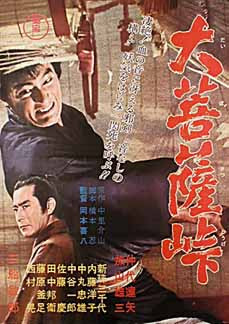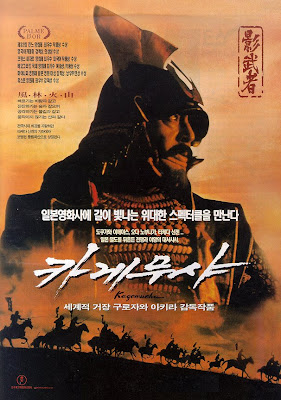First is the idea of a "Shadow Warrior", a man who is made to be a double for a dying warlord, is a concept that is immediately both interesting and intriguing.
Then there is the performance of Tatsuya Nakadai, playing dual roles. Of note is his portrayal of the thief who grows to immerse himself into the role of the warlord that he is forced to play, even coming to care and make the ultimate sacrifice for the clan. You can tell that Kurosawa instructed Nakadai to mimic Toshiro Mifune, but Nakadai plays his part very well. He may never be a Mifune, but at least in Kagemusha he hardly looks out of place.
Ultimately for me, Ran as a story falls behind Kagemusha because it appears to be more formulaic. Audiences will root for the thief in Kagemusha simply because the story is less predictable and because the thief grows a heart along the way.
We do empathise with Hidetora in Ran, but when we can tell what is going to happen even at the end, then it is going to be that harder for the story to strike a chord.
Compare that with the Kagemusha's final futile charge, I grief and despair with the character, knowing full well that he could easily have turned away from it all - but chose not to.
The final moments from Ran and Kagemusha are both equally sad, but it is Kagemusha and that brave sacrifice that earns the film this spot for me.
With a grand total of just two fight scenes, one could hardly call this a swashbuckling samurai action film. Instead, it tells the story of a humble samurai, struggling to care for his family after the loss of his wife to illness.
The film portrays the life of the samurai in an era when their swords are no longer needed.
Hiroyuki Sanada plays the impoverished and unkempt samurai who disappears at sunset after each working day, leading his colleagues to nickname him the Twilight Samurai.
The film takes a look at the samurai in a changing era, but really, it is also a story of a man who only yearns for a simple life with his family - and a budding childhood love.
But even as times are changing, the strict samurai code and conservative traditions can get in the way of true happiness. A quiet love story - where less is said, and more is shown.
But this is not about linguistics - it's about an instant classic - one that rivals a Kurosawa even at its peak.
To the untrained viewer, the pace is slow. The narrative however, slowly draws you in.
An ageing ronin (wandering samurai) recounts his tale in front of a clan of samurai, with whom he has requested a seppuku ceremony (effectively an assisted suicide). But all is not as it seems, and the tale unravels into an explosive conclusion.
This is not simply a tale of samurai sword fighting, but also an outside look at samurai culture and the sometimes harsh and unrelenting nature of honour and traditions.
Tatsuya Nakadai delivers another impeccable performance. I hadn't really heard of him but he has already made quite a few appearances on this list. Can he actually be better than the great Toshiro?
And here is the reason why. The performance of Toshiro Mifune in Rashomen is groundbreaking, both for his career and also for the way future films portray their heroes. Mifune was said to have studied footage of lions in the wild in order to perfect his acting for this role.
His wild, often animalistic acting style paved the way for acclaimed performances in films like Yojimbo or Sanjuro, and even Tatsuya Nakadai pretty much emulated Mifune in Kagemusha.
But Rashomen is not simply about Mifune. If there ever was a film that showcased the perfect balance and partnership between Kurosawa and Mifune - then this was it.
Rashomen not only featured the raw & immense talent of Mifune, but also set a new standard for cinema in its unconventional storytelling and use of filming techniques.
A crime is committed, and all the parties involved recount the events of the crime from their point of view - except that their stories are all different from the other, leading to the confusion as to what actually represents the truth.
This plot device became so famous, it came to be known as the Rashomen Effect. One well known film that adopted a similar approach is Zhang Yimou's Hero. And there are others.
To be honest though, When the Last Sword is Drawn is probably not as well made as it could have been. There are quite a few flaws that detract from the overall experience. Certainly it is not as visually inspiring or beautiful as Twilight Samurai.
It also employs the device of parallel timelines to tell a story of yesteryear. It's not that it is particularly confusing as such devices can be. But the execution feels tired, cliched, and ultimately, probably unnecessary.
Nonetheless, the story of a money grubbing samurai who joins the Shinsengumi, and how it slowly unfolds to reveal a man of incredible loyalty and patriotism (if not honour), willing to sacrifice his all for family and country - this is a story that is at once unlikely, yet incredibly heartwarming and sadly, tragic.
In many ways, I think a good story can make up for slightly inferior production value, and this is one example that outlines this clearly. I am not saying this film is poorly made - far from it - rather I would say, this is one film that does not rely on artistry to tell a gripping tale.
This film is so iconic, it has set the standard for a genre of film that features a motley collection of heroes. The Magnificent Seven; Seven Swords; Ocean's Eleven; and even in animated films like A Bug's Life - plus so many, many more - have been modeled after Seven Samurai.
It's not even funny - it's like a textbook for film students.
The wise leader; the complementary advisor; the reliable soldier; the brooding genius; the funny man; the young apprentice; and the big buffoon. Do you recognise these archetypes in the film and who played what?
A village finds itself threatened by bandits, and sends representatives into town to hire some samurai to defend its land and crops. Seven samurai sign up - and the rest is history.
Masterful performances from Takashi Shimura (another Kurosawa veteran) and Toshiro Mifune, who easily steals the show as the loudmouthed samurai with the big sword. But as with all films of this genre, the film also relies on the interplay between the seven heroes, and also the villagers who hire them.
If you have to watch only one samurai film - this has to be it. No other film even comes close - really.

































